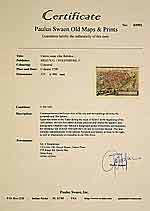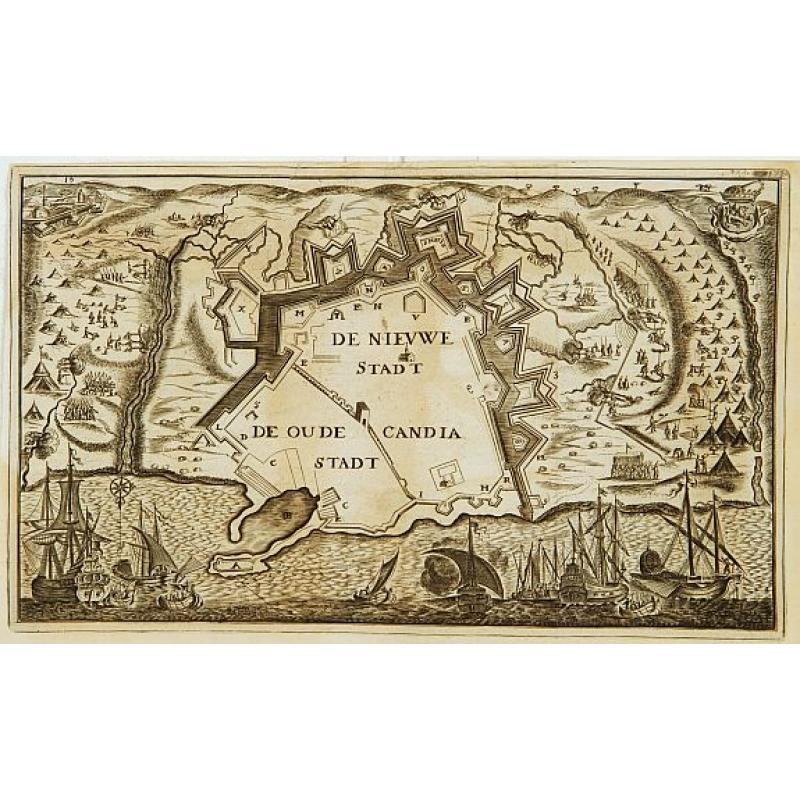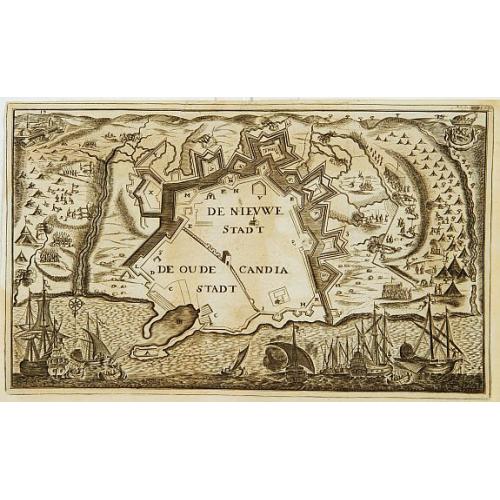Lot #: 16769
De Nieuwe Stadt / De Oude Stadt Candia. |
||||||||||||||||||||
|
||||||||||||||||||||
|
|
||||||||||||||||||||
|
Selling price: $200
Sold Join our News Letter to get informed when a similar item comes available. Do you have an example you would like to sell? |
Views: 499
|
|||||||||||||||||||
Description
Rare plan of the town of Candia. With extensive shipping on foreground and Turkish troops sieging the town.
The Siege of Candia (Heraklion, Crete) (1648-1669) was possibly the longest siege in history.
In 1645, 60,000 Ottoman Turks led by Yussut Pasha disembarked on Venetian Crete and occupied Chania (La Canea) and Rethimno (Rettimo). Both of these cities took two months each to conquer. Between 1645 and 1648, the Turks occupied the island rest of the island and prepared to take the capital, Candia.
In May 1648, the siege of Candia began. The Turks spent three months investing the city, which included cutting off the water supply. For the next 16 years, the Turks bombarded the city without being able to gain entry.
During the siege, the Venetians tried to raise European and Papal support for their defense of the island. While some assistance was forthcoming, the Venetians generally stood alone.
Being a sea power, the Venetians sought to blockade the Dardanelles to prevent the Turks from resupplying their troops on Crete. In 1655 the Venetian navy was victorious against the Turkish navy. On 26 August 1656, the Turks suffered their most crushing defeat since the Battle of Lepanto (1571), although the Venetian commander, Lorenzo Marcello fell. On 17-19 July 1657, the Venetian navy was beaten by the Turkish navy, and the Venetian captain, Lazzaro Mocenigo was killed by a failing mast.
On 7 November 1659, with the signing of the Treaty of the Pyrenees and peace between France and Spain, Venice received more aid from the Christian states. However, after the signing of the Peace of Vasvár (August 1664), the Turks were also able to bring more forces to bear.
The turning point was the decision of the French to leave Candia in August 1669. General Sea Captain Francesco Morosini, commander of the Venetian forces, was left with only 3,600 fit men to defend the fortress. He surrendered to Grand Vizier Achmed Koprolu (Kioproulis) on 27 September 1669.
The Siege of Candia (Heraklion, Crete) (1648-1669) was possibly the longest siege in history.
In 1645, 60,000 Ottoman Turks led by Yussut Pasha disembarked on Venetian Crete and occupied Chania (La Canea) and Rethimno (Rettimo). Both of these cities took two months each to conquer. Between 1645 and 1648, the Turks occupied the island rest of the island and prepared to take the capital, Candia.
In May 1648, the siege of Candia began. The Turks spent three months investing the city, which included cutting off the water supply. For the next 16 years, the Turks bombarded the city without being able to gain entry.
During the siege, the Venetians tried to raise European and Papal support for their defense of the island. While some assistance was forthcoming, the Venetians generally stood alone.
Being a sea power, the Venetians sought to blockade the Dardanelles to prevent the Turks from resupplying their troops on Crete. In 1655 the Venetian navy was victorious against the Turkish navy. On 26 August 1656, the Turks suffered their most crushing defeat since the Battle of Lepanto (1571), although the Venetian commander, Lorenzo Marcello fell. On 17-19 July 1657, the Venetian navy was beaten by the Turkish navy, and the Venetian captain, Lazzaro Mocenigo was killed by a failing mast.
On 7 November 1659, with the signing of the Treaty of the Pyrenees and peace between France and Spain, Venice received more aid from the Christian states. However, after the signing of the Peace of Vasvár (August 1664), the Turks were also able to bring more forces to bear.
The turning point was the decision of the French to leave Candia in August 1669. General Sea Captain Francesco Morosini, commander of the Venetian forces, was left with only 3,600 fit men to defend the fortress. He surrendered to Grand Vizier Achmed Koprolu (Kioproulis) on 27 September 1669.
FAQ - Guarantee - Shipping
In our BUY-or-BID sale, you never pay more than the Buy price.
To buy or bid in this Buy-or-Bid sale you must register with us. It is free, and we automatically update you about future auctions.During the Buy-or-Bid sale, you can buy or bid on 600- 900 antique, rare maps, town views, old master prints, decorative prints, atlases, posters and Medieval manuscripts.
- We show the "Bid & Ask spread" (to define the gap between the minimum accepted bid and Buy price.)
- Items that have received bids within the BidAsk spread are sold at the highest bid at closing.
- Once the Buy price is paid, the sale for this item has closed.
Do you have a similar item you want to sell ?
Interested in selling your antique maps, original prints, vintage posters, or historic Ephemera?Let us help you!
Start your consignment today. We provide estimates free of charge from photographs sent via the Internet. Fill out our online estimation form, and we will contact you with an estimate.
Learn more about consigning at RarePaperSales.com
Guarantee
 We warranty the authenticity of each lot offered in our sale. There is no time limitation to this guarantee.
We warranty the authenticity of each lot offered in our sale. There is no time limitation to this guarantee.- Defects in lots have been carefully noted.
- If there are no remarks regarding splits, tears, discoloration, etc., there are no issues to be found for the item!
- All items are carefully and personally examined before being packed "in-house" and shipped by UPS, USPS, DHL or registered mail.
- We do not sell reproductions.
- A certificate of authenticity is provided for each acquired item and can be downloaded from your invoice page.
- Certificates can be found in the Invoice and Certificates center.
Shipping
Maps are shipped in solid tubes or flat between solid cardboard. Fully insured, signature required, and with online tracking. Shortly after shipment, you will get the tracking number by email.The standard is that we ship items by UPS or DHL for European destinations, and a flat shipping fee is added to each shipment. It is a one-time fee even if you buy multiple items. This fee covers shipping and insurance (up to the invoice amount) to:
- North America, Canada, Europe $ 30
- Asia $ 40
- For South America, Mauritius, Africa and Australia a shipping fee of $ 50 will be charged.
We charge only a one-time shipping fee if you have won 2 or more items.

Hold Shipment Service
Rare Paper Sales allows you to put your shipping on hold at no additional charge. This can be incredibly convenient for people who want to buy several items at different auctions and ship them together. The service is free, and you pay only one shipment fee.
Contact us if you want to use the Hold Service.
High-Resolution Digital Image Download |
|
|
RarePaperSales maintains an archive of most of our high-resolution rare maps, prints, posters and medieval manuscript scans. We make them freely available for download and study. Read more about free image download |

